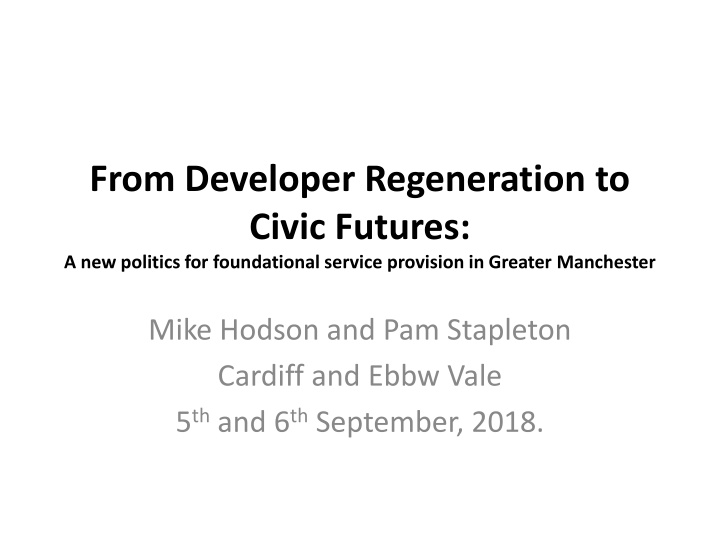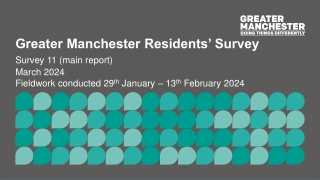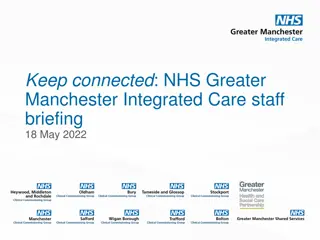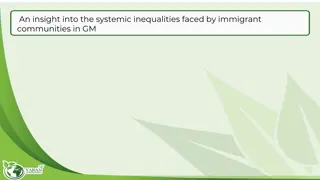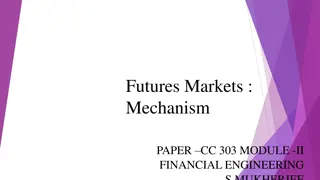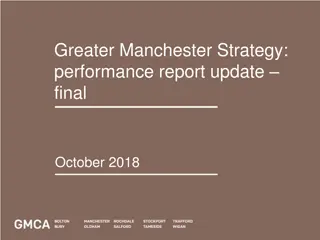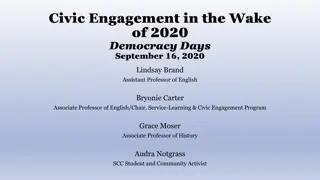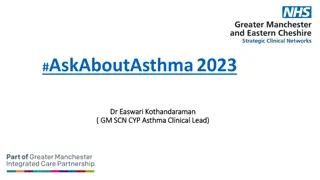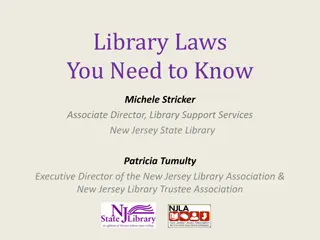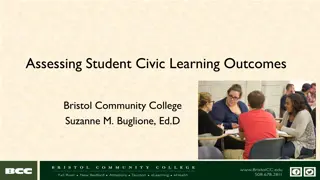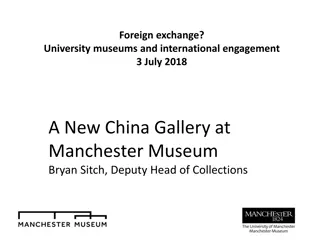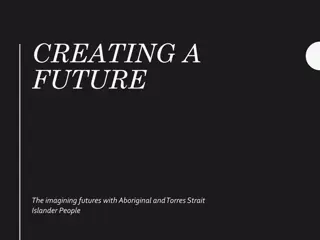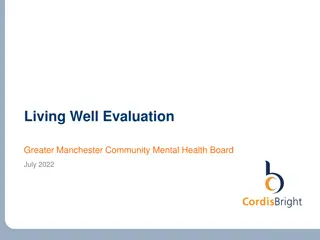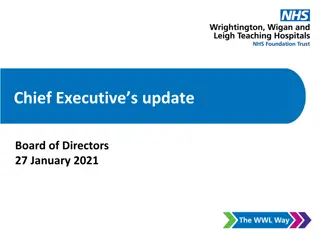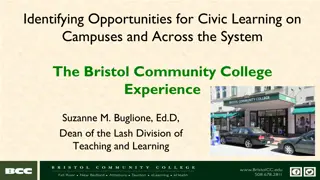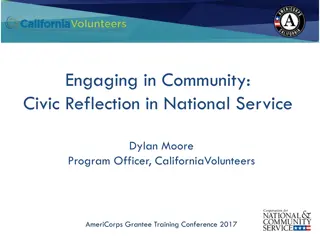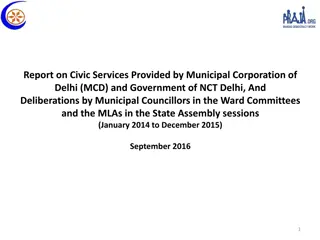Transforming Greater Manchester: A Journey from Municipal Plans to Civic Futures
A historical analysis spanning 100 years documents the transformation efforts in Greater Manchester, from the Municipal Plan Era (1945-1986) to Developer-Led Regeneration (1986-onwards). The post-war period saw ambitious visions for social infrastructure, while the later phase focused on business-friendly strategies, leading to housing crises and transport challenges. The need for a paradigm shift towards civic futures is emphasized to address the current shortcomings.
Download Presentation

Please find below an Image/Link to download the presentation.
The content on the website is provided AS IS for your information and personal use only. It may not be sold, licensed, or shared on other websites without obtaining consent from the author.If you encounter any issues during the download, it is possible that the publisher has removed the file from their server.
You are allowed to download the files provided on this website for personal or commercial use, subject to the condition that they are used lawfully. All files are the property of their respective owners.
The content on the website is provided AS IS for your information and personal use only. It may not be sold, licensed, or shared on other websites without obtaining consent from the author.
E N D
Presentation Transcript
From Developer Regeneration to Civic Futures: A new politics for foundational service provision in Greater Manchester Mike Hodson and Pam Stapleton Cardiff and Ebbw Vale 5thand 6thSeptember, 2018.
1. Argument in Summary A 100 year historical sweep through 3 phases of efforts to transform Greater Manchester. Brief overview of the post-war period from 1945 1986 Focus on organising vision and its problems for the period from 1986 to date Present our vision of civic futures Are we at a point of change? Nature of the vision How can more change happen?
2. Municipal Plan Era 1945-1986 Problem poor living and working conditions in industrial city. Vision modern city region, universal provision of foundational services, social infrastructure per population, slum clearance, centre adapted to car. Means top down state, professional local authority planners and engineers with masterplan, assumption of benign competence Finance Public tax funding from centralised state creating frameworks for local action Outcomes much of the ambitious 1945 plan never built or revised (badly) in execution for cost reasons. Even though not as planned poor outcomes discredited town planning By 1980s monetarist economic policy brought a high pound and high interest rates, 20% of UK manufacturing jobs lost permanently in the first recession of the early 1980s. Deindustrialisation then rolled on through the 1980s and 1990s in Greater Manchester, stripping out jobs and leaving many vacant ex-industrial brownfield sites.
3. Developer Led Regeneration 1986 -onwards Problem deindustrialisation fix, knowledge economy Vision a competitive business-friendly city region Means developer led, PPPs, with facilitation by state. Housing (rented flats) extending the city centre - for those with market income, warehousing around the periphery close to motorways. Finance public private bank / market funding prioritised by attractiveness to market, state funds for transport for commuters (radial to city centre jobs). Elites dominate decisions. Social infrastructure a blind spot as social claims in planning applications fall away
3. Outcomes of Developer Led Regeneration 1986 -onwards Approach has contributed to growing crisis in provision of housing, transport & other foundational services Exemplified in current state of housing Owner occupancy declined amongst younger age groups 80,000 waiting list for social housing which is not being built in any quantity Growing homelessness and rough sleeping problem And current state of transport GM accounts for 37m km per day of travel, vast majority (77%) of which are travelled by car With consequences for congestion, public health and air pollution which brings several thousand premature deaths each year No convincing GM plan for managing car-based growth; in policy documents, transport framed as a lever for enhancing selective, developer -led economic growth
3. GM Transformed from the 1990s: in summary Figure 4: Net change in population, UK cities, 2001- 2011 i) Developer-led regeneration has repopulated Manchester city centre - from a few hundred people in the 1980s to 30,000 by bringing in young singles and couples Developers increasingly built-up in high rise with 1-2 bed flat units on brownfield sites in Mcr city centre and Salford Quays 1-2 bed flats aimed at a particular demographic, particularly 25-34 year old junior white collar workers Between 2001 and 2014, the population of 25-34 year olds increased by 47,000 in the two boroughs of Manchester City and Salford and actually declined in all the eight other boroughs of Greater Manchester. ii) Developer-led regeneration now means whole districts are named and parcelled for the construction of thousands more apartments which will create an urban mono culture of private-rented blocks Growth in the number of residential apartments, planned and under construction in Manchester city centre since 2014, has been spectacular The pipeline of planned, approved and under construction apartments involves a relatively small number of developers and land owners Major developers have a close relation with MCC, sometimes through joint ventures; and/or through MCC setting area development framework & in some instances providing loans from GMHF
3. GM Transformed from the 1990s: in summary iii) Developer-led regeneration has done very little for the vast majority of the GM population which lives & works elsewhere & only visits or passes through the privileged sites Produced an expanding new town in the centre whose shiny, shiny external appearance offers very little to most GM citizens beyond Done little to remedy painful inequalities within and between GM boroughs iv) Developer-led regeneration meant that in planning-related areas LAs lost their public service compass and came to serve property developers not citizens In many areas LAs have statutory responsibilities for foundational services which they try to fulfil despite gross underfunding MCC and Salford Council got little back from developers while providing them with various kinds of financial support including loans v) Underpinning this has been the development of highly complex governing structures over the last three decades where lines of accountability to GM citizens have often become difficult to follow Prior to 2017 election of first GM Mayor, none of the restored GM governing institutions had directly elected members Planning developments in city centre under remit of MCC but transport under overall governance of TfGM - result has been a policy mess Meanwhile, very few citizens could explain who is responsible and what those responsible could or should do about it at city region level
4. GM Combined Authority Plans for the future Yet, recent strategic plans from GMCA attempt to intensify this unbalanced approach 2016, draft GMSF 20yr strategy for housing, land-use, employment and (narrowly economic) infrastructure Overall target - land for 227,000 homes and 200,000 jobs (with social housing, job quality, digital job automation and the contraction of local retail all largely invisible) Proposed to meet target through: Infill of remaining ex industrial sites in city region s centre Large edge city housing developments (some on greenbelt) Warehouse parks for logistics operations Will deliver planned, uneven development in a mosaic city If implemented, will shape long-term future by materially re formatting city-region and everyday life of citizens
4. Limits to developer regeneration and what comes next? Overarching consequence, by 2017, was an experimental but increasingly solidified political mobilisation End of a 30 year period? Limits of developer regeneration becoming more obvious GMSF being revised after it provoked 27,000 responses GM political classes publicly & awkwardly caught between developers & citizen electors
5. Thinking about alternatives and transformation At this critical historical juncture where the struggle is over intensification of developer regeneration and the development of alternatives, our constructive aim is to: think critically about the limits of developer-regeneration and the future of Greater Manchester and to contribute to alternative thinking about new forms of political organisation and new economic priorities which could start to shape the future of the city-region as a diverse, civilized place aimed at citizen well-being: a new civic future for Greater Manchester.
5. Limits to developer regeneration and what comes next? Beyond critique, what might an alternative to developer regeneration look like? Answer not simple because of the absence of class project and cultural identity in GM And given the persistence/embeddedness of Developer Regeneration Rather than being driven by class politics or cultural identity, GM can draw upon a voluminous and fragmented counter culture of diverse small groups centred on places or issues The issue these kinds of groups have always had has been about how their influence and the lessons learned from them can spread beyond their immediate locality - scaleability and puritanism
Current, Old and New Ways of Transforming Greater Manchester Developer regeneration is about more than developers 1. Transformation needs to be understood a complex set of political relationships 2. That needs to be understood in historical context and comparatively
Figure 2: Political mobilisation in three periods: a century of remaking (Greater) Manchester, 1945-2045 Municipal Plan (1945-1986) Local authority, planners and engineers working to a masterplan Developer Regeneration (1986 onward) Growth coalition (political, business and developer elites) Civic Futures (from now -2045?) Wide range of place-based social interests and intermediaries working with political decisionmakers Building the citizen s city-region Failure of collective provision in a rich society Experiments with co-producing heterogeneous services Changemakers Vision Orientating pressures Building the modernist city-region Poor living and working conditions in industrial Manchester Collectivise/ nationalise foundational services in the industrial economy Building the competitive city-region Fixing deindustrialisation; search for post- industrial knowledge economy Cultivate new, business friendly economic identity for a post-industrial city-region Focus and purpose Housing, transport and foundational services Work towards universal provision Selective and prioritised provision according to market income and private consumption decisions Re-discovering universal standards of collective provision in a heterogeneous context Bottom-up / generative from citizen needs Social infrastructure Top-down, generic recipe and integral Blind spot/ invisible; run down legacy provision Controlling, parsimonious central state, promoting competition , constraining local action Public-private partnerships, top-down with developer priorities facilitated by repurposed state; change by elite governance where citizens consulted after things have been decided Relationship between national state and GM Governance and democratic participation Centralising, to create frameworks for local action Need for enabling central state Public authorities, nationalised corporations, top-down state assumed benign and competent; done to citizens Civil society and intermediary institutions in co-producer role, i.e. non- state can plan, deliver and own the collective; enabling state; change via challenging elite governance and demonstrating alternatives Knowledge, expertise and participation Finance Professional planning and engineering Developer-led with financial and legal Granular place-based knowledge of citizens informs strategy Multiple sources, with public funding from reinvented taxation Capillary networks and distributed branches across the City expertise bought in Public-private Public, tax-spending Geography New towns ie council estates, centre adapted to car etc , Infilled and now an extended city centre, edge city and priority consumption spaces such as airport and Trafford Centre Number of jobs created; GVA; levels of inward investment Measures of success Levels of connection to foundational services; no. of social houses built Citizen wellbeing measures related to quantity and quality of services
5. What is to be done? Civic futures Focus on new civic futures Is not about either a statist model or a market model. It is a commitment to doing city-regional politics, policy and governing differently than has been the case for a generation It is based on building a city-region for the people of Greater Manchester. One that genuinely involves the citizens of Greater Manchester in that process But that does so as part of a new political configuration The call for new civic futures is not a na ve call for participatory democracy. It is A call for a new political mobilisation in Greater Manchester One which is based on citizens needs for and access to foundational services, their engagement with and involvement in the process of shaping these services, but also linking this up to formal policy and expertise This is a multi-decade process, but one which should start now.
